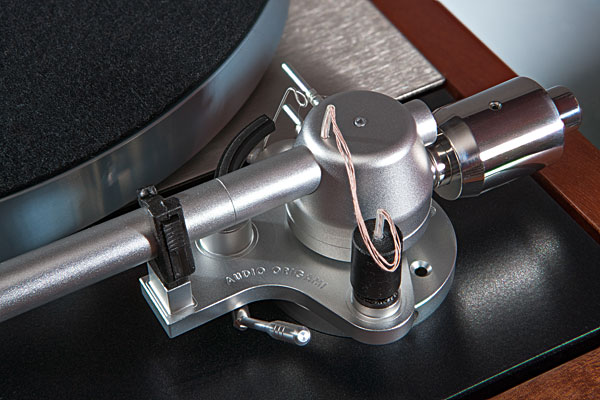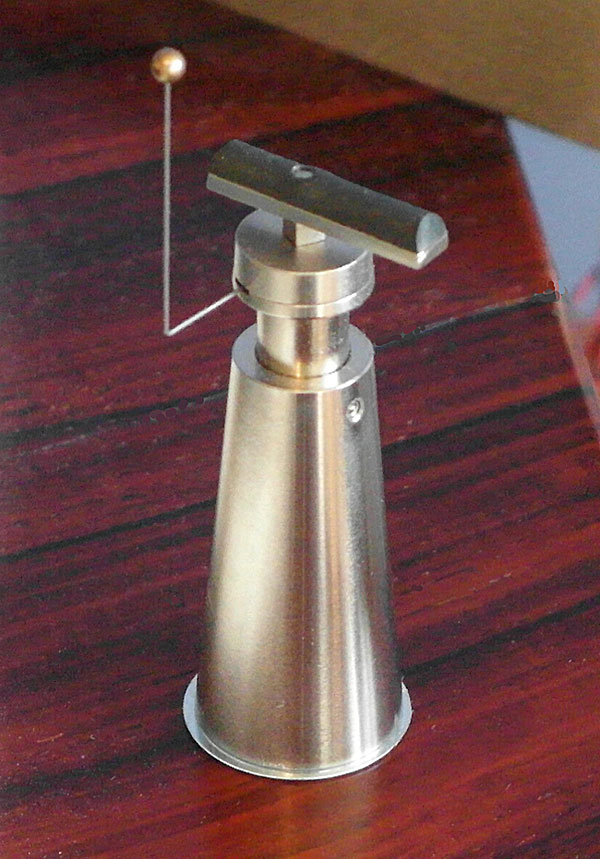| Columns Retired Columns & Blogs |
..about the Linn LP12...very alluring. I came close to buying one circa 1980 but the deal fell through. It's been Rega ever since..
While using the LP Nude Graverobbers from Uranus, by Dick Dribble and the Doctrinaires (footnote 3), to check the resonant behavior of the pairing of Audio Origami UniArm with Denon DL-103, I noticed that, in the lateral plane, the combination exhibited a very mild resonance from 11 to 13Hz; in the vertical plane, a resonance of similar mildness made itself known from 10 to 12Hz. Note that this test—and all listening—was performed without filling the sapphire bearing cup with the thick silicone fluid Audio Origami supplies with the arm for users who feel the need to add to the bearing a degree of damping. My decision was based partly on the fact that the UniArm never sounded as though it needed such a Band-Aid, and partly because silicone is pernicious, unhealthy stuff, the use of which I resist whenever possible.

Scattered amid all that fiddling was a lot of listening—and by the time I got everything just so, the record on the platter was West Meets East (1966), by violinist Yehudi Menuhin and sitarist Ravi Shankar (Angel 36418). With the UniArm spanning the gap between my Linn turntable and Denon cartridge, the sound was, as I noted on a nearby scrap of paper, "surprisingly good." I wasn't shocked by how well this LP12-based combo followed the sinewy melodies, nor was I surprised by the apparently perfect yet nonetheless human sense of timing with which it imbued these recordings. What did surprise me were the rich timbral colors, the no-less-rich textures, and the fine sense of pull I heard: In the album opener, Prabhãti—a conversation between Menuhin and tabla player Ustad Alla Rakha, with Prodyet Sen's tambura heard faintly, the violin's many long, sustained notes communicated the appropriate tension: they suggested musical momentum in a manner that's hard to describe but, once heard, easy to identify.
Later, I would go back and compare the sound of that record on my usual player, a Garrard 301 turntable with EMT 997 tonearm and Shindo SPU cartridge, the latter driving an Hommage T1 step-up transformer. (I used the Denon cartridge with the step-up transformers built into my Shindo Masseto preamp.) The one area in which the Linn-Origami-Denon player failed by comparison was in impact: the Garrard-based player allowed the tabla, in particular, a much greater degree of force. But the Linn-based player had that momentum, that pull—which, combined with luscious tone and superb tunefulness, just about made up for its relative lack of force.
When I repeated that comparison with a different and altogether larger-scale recording—Dame Janet Baker singing Elgar's Sea Pictures with the London Symphony Orchestra, under the direction of Sir John Barbirolli (EMI ASD 655)—things shook out along more or less the same lines. With the UniArm in place, the Linn player amazed me with its musical momentum and, especially, its very good texture and color—the bass clarinet at the end of "Where Corals Lie," which tends to get lost in the shuffle with lesser gear, emerged realistically from the mix—although the pizzicato violins in "The Swimmer" weren't as tactile or impactful as they might be. Still, the end result was sufficiently dramatic, and very pleasing overall.
A better comparison was with another Linn-friendly tonearm and the same turntable and cartridge. After spending time with the Audio Origami UniArm, I steeled myself for another hour of LP12 setup misery and swapped back to my Rega RB300, long a favorite for its good sound and very high value. (Since I bought my sample over a quarter-century ago, the RB300 has been replaced with the RB330, which sells for $595.) Love the Rega arm though I do, the differences were all in the Origami's favor, and none was more crucial than the unipivot arm's slightly meatier way with musical colors and similarly more substantial spatial presentation. With "Alfie's Theme," from Sonny Rollins's Alfie: Original Music from the Score (Impulse! A-9111), literally all of the instruments—Rollins's tenor sax, Kenny Burrell's guitar, the brass ensemble highlighted by J.J. Johnson, you name it—sounded just right with the UniArm but comparatively thin through the RB300, which is not, in and of itself, a thin-sounding tonearm. Those distinctions were repeated again and again with each subsequent record I played.
Did the Audio Origami UniArm sound exactly like the Naim Aro? The new arm had at least the same sort of musicality as its famous predecessor—the same ability to not just follow melodies but urge them on, with as much nuance as one can hope to hear from a record. And the UniArm's frequency range was surely no less than the Aro's—in addition to which, the new arm sounded just as poised on difficult records, at least with my Denon cartridge. I can't quite say the UniArm made me forget my Naim Aro—or, for that matter, the excellent and similar-sounding AMG 9W2 ($3500)—but it sounds as if cut from the same cloth, and, for a new product available in the here and now, it offers better value for the dollar than did the Aro in its later years. The UniArm is an excellent choice for the LP12—and, possibly, other, similarly musical turntables—and it makes me very interested in hearing Audio Origami's PU7 (ca $3000).
Getting it up
Neglectful, slipshod, remiss, altogether derelict—those words describe my behavior during the months between the end of the 2015 New York Audio Show and the beginning of that show's 2016 edition.
Well, maybe not every minute of every day—but at least for a goodly chunk of time subsequent to receiving a review sample of the Little Fwend automatic tonearm lifter ($249), whose eponymous Norwegian manufacturer was among the exhibitors at NYAS 2015. The Little Fwend had impressed me at that show, where it was demonstrated with a Thorens TD 124 turntable and Thomas Schick tonearm, examples of both of which I own.
I was even more impressed when I received the review sample. Not only is the Little Fwend beautifully made—its aluminum alloy and steel parts are machined with a degree of precision that would not be out of place in the finest tonearms—but its curiously shaped wood-and-paper packaging is equal parts smart, informative, whimsical, and helpful.
Inspired by the first such product to enjoy widespread success—Audio-Technica's AT-6006 Safety Raiser, now discontinued—the Little Fwend is a damped, spring-loaded cueing platform mounted atop a tapered steel cylinder. Once it's installed on the turntable's plinth, chassis, or armboard, its user sets the lifter by pressing the cueing platform down to its lowest position—low enough that the armtube will pass over its neoprene rubber surface during play, with just a millimeter or so to spare. Then, when the stylus wanders into the lead-out area at the end of the side, the armtube presses against a short, upright length of piano wire, triggering a spring inside the Little Fwend that raises the cueing platform by about 2.5mm. It isn't nearly as Rube Goldberg as I make it sound—within a second of contact between armtube and tripwire, the cueing platform briskly but not jarringly lifts the tonearm straight up from the record, stylus and all.

On their website, Little Fwend suggests that their lifter is suitable for use with vertical tracking forces (VTFs) of up to 5gm—precisely the recommended VTF for an EMT OFD 15 mono pickup head, which I happened to be using on my combo of Garrard 301 turntable and EMT 997 tonearm when I finally tried the Little Fwend. Installation was not difficult but required, at first, a bit of time and care to orient things just so. To that end, the untriggered height of the Little Fwend's cueing platform is adjustable within a range of about 9mm—and the lifter is available in two identically priced versions, High and Low, whose cylindrical bases are differently sized for different turntable-to-armtube dimensions. Also, because the Little Fwend is held in place by a powerful rare-earth magnet—it snugs against a very thin steel disc that self-adheres to the user's turntable—it can easily be rotated to optimize the tripwire position, depending on where a particular record's lead-out groove begins (footnote 4).
Since the first day I tried it, a few weeks ago as I write this, the Little Fwend has performed reliably and smoothly, sparing my styli untold minutes of wear—and every minute counts. It even once saved the bacon of my EMT OFD 25, when I used it to play a record in my collection that I'd gotten from a local library. (Someone, may God forgive him or her, had thought it a good idea to put plastic-tape Dymo Label Maker labels in the lead-out area of every one of that library's LPs.) That's a pretty good savings right there!
Not since the Dual 1218 turntable I owned ca 1972 have I had an automatic record player—ie, one whose tonearm lifted at the end of the record, with no coaxing on my part. Nor, since then, have I needed such a thing.
Until now. And it isn't just a question of having 45 years on my odometer that weren't there when I owned that Dual—which, incidentally, I could never get to play upside-down, as the salesman assured me it would. (Let's not go there.) Rather, it has more to do with my having bought, in recent years, a bunch of 78rpm records: things that spin fast enough that, on more than one occasion, my stylus has burst inertia's bonds and blasted its way, NASCAR-like, over the lead-out groove and toward the spindle.
An interesting technical aside: As effective tonearm length increases and the arc of the stylus's travel across the record thus more and more closely approaches a straight line, the offset angle of the cartridge and the distance by which the stylus overhangs the spindle approach more closely the respective ideals of 0° and 0mm. This sounds good—it is good—but for users of long tonearms such as I, it means that a careening tonearm is that much more likely to cause the cartridge's cantilever to be taken out by the resolutely stationary spindle. Yikes!
Using a strip of paper whose stiffness I'd "measured" with the aid of an electronic stylus-pressure gauge, I tested the Little Fwend's tripwire and found that it requires about 0.75gm of pressure to trigger the raising of the cueing platform. There surely exists a reader who's clever enough to perform acceleration-and-impact calculations on tonearms of varying mass (my 12" EMT 997 is surely on the high side of the range) and at different platter speeds, to determine if the Little Fwend will work in most settings. I await their findings with thanks in advance.
The Little Fwend, the name of which you will hate or love, is one of the most well-conceived, well-packaged, well-made audio accessories I have encountered. I recommend it without hesitation.
Footnote 4: Dimensions of which vary widely, as Keith Howard observed in "Arc Angles: Optimizing Tonearm Geometry," in the March 2010 issue.

..about the Linn LP12...very alluring. I came close to buying one circa 1980 but the deal fell through. It's been Rega ever since..

Love the photos. Goes to show how the virtual format can supplement the written one.

Recently sold my TD-124 which Mr. Dudley still uses as a reference, and went back to a relatively new LP12 to replace one I sold 10 years ago and regretted selling. What can I say, like an old friend I hadn't seen in 10 years, picked off right where we left off. This tonearm review interested me as did getting an Aro for the table, but decided to go way out of left field and purchase a new SME IV. Call me crazy but I think it will work quite nicely.